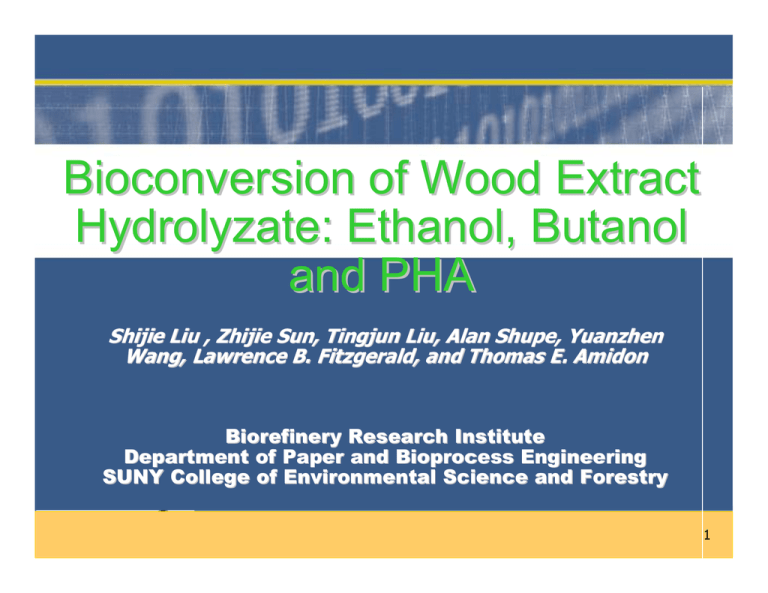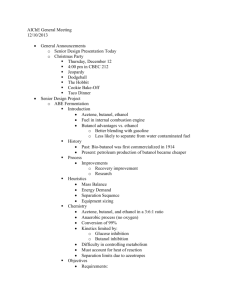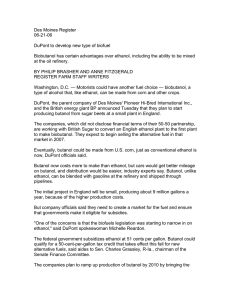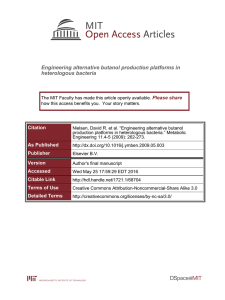Bioconversion of Wood Extract Hydrolyzate : Ethanol, Butanol
advertisement

Bioconversion of Wood Extract Hydrolyzate: Ethanol, Butanol and PHA Shijie Liu , Zhijie Sun, Tingjun Liu, Alan Shupe, Yuanzhen Wang, Lawrence B. Fitzgerald, and Thomas E. Amidon Biorefinery Research Institute Department of Paper and Bioprocess Engineering SUNY College of Environmental Science and Forestry 1 Imagine a renewable world 2 Outline Introduction Ethanol Butanol PHA Conclusion 3 Hemicellulose Common among angiosperm woody biomass: 4 Integrated Biorefinery: Woody Biomass Residual Woody biomass Hot-Water Extraction Co-Gen or CHP Gasification Feedstock Extraction Liquor Alkaline Puling Electricity and Steam Reconstituted Wood Products Separation or Co-Gen Plastics Adhesives Solvent Surface agents Carbohydrates Aromatics … … … Sugars Food additives: sugar oligomers Black Liquor Paper products or Cellulose products Hydrolysis / Separation Acetic Acid Fuel Pellets Unbleached Pulp Bleached Pulp Methanol Pulping Chemicals Xylitol Ethanol Butanol Acetone Hydrogen Lactic Acid PHA 5 Inhibitors Phenolics – orignated from lignin and extractives of woody biomass Acetates, formate, furfural, HMF Detoxification X More steps in product recovery ? Microorganism adaptation f1 (ppm) Hot-water Wood Extract Hydrolyzate Fermentation Ethanol E. Coli Pichia Stipitis Butanol Clostridium acetobutylicum Clostridium beijerinckii PHA Burkholderia cepacia 8 Ethanol from Wood Extract Hydrolysates with Pichia Stipitis 20 Ethanol Concentration, g/L NRRL Y-11543 25% Hydrolysate 50% Hydrolysate 75% Hydrolysate 100% Hydrolysate 15 10 5 0 0 1 2 3 4 5 6 7 8 Time, days 9 Adaptation of fermenting microorganism hydrolysate challenge overnight culture FBR5 overnight culture fermentation medium liquid medium compare with parent dilutions plating selective medium 10 Two new fermenting strains E. Coli fbhw P. Stipitis hw Ethanol by E. Coli FBHW 40 120 30 100 20 80 60 Reducing sugar Ethanol Cell 40 10 0 20 0 1 2 Time, day 3 4 Ethanol, g/L or cell, 0.1g/L Reducing sugar concentration, g/L 140 Solvent concentration(g/L) Butanol Production ATCC 824 12 10 Total solvent 8 butanol 6 4 2 0 0 40 80 120 Time (hour) acetone ethanol 160 13 Conclusions Wood extract hydrolyzates are reactive Ethanol production reached 35 g/L for both E. Coli and P. Stipitis Butanol production reached close to 10 g/L PHA production started. Challenges Feedstock variation Butanol concentration still low PHA – not extracelluar product 14 Acknowledgements ■ Christopher D. Wood Dave Kiemle Raymond Appleby ■ Ruofei Hu Jennifer Putnam ■ Kathryn Gratien Others 15 Acknowledgements NYSERDA US DOE 16 Thanks! 17





